Admitting you were an Inter fan growing up is probably not the best way to regain the trust of the AC Milan supporters when you are already under pressure, but Marco Giampaolo admitted his support for his side’s cross-city rivals in an interview before his final match against Genoa.
Since joining the club this summer from Sampdoria, Marco Giampaolo ultimately was the first Serie A manager to lose his job after a rocky start to the season, and in this tactical analysis scout report, I’ll take a look at why Giampaolo failed at AC Milan.
Defensive shape
Typically, Giampaolo set AC Milan up in a 4-4-2 diamond, but this shape varied. Against Brescia and Hellas Verona, he fielded the Rossoneri in a 4-3-2-1, favouring an extra attacking midfielder rather than a striker. In his final match against Genoa, he played a 4-3-3.
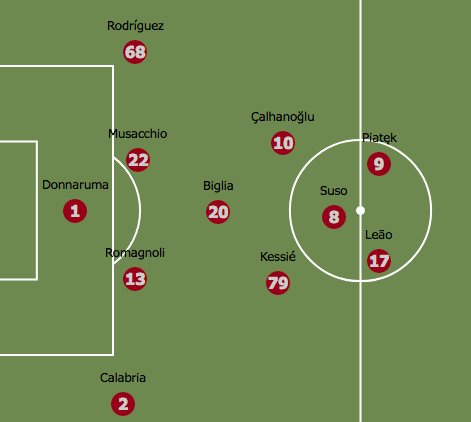
Defensively, AC Milan’s shape would stay narrow, the two outer central midfielders position themselves in the half-spaces, the defensive midfielder screening the defensive line, while the attacking midfielder acts as the midfield’s first line of defence, attempting to cut out any central passing lanes.
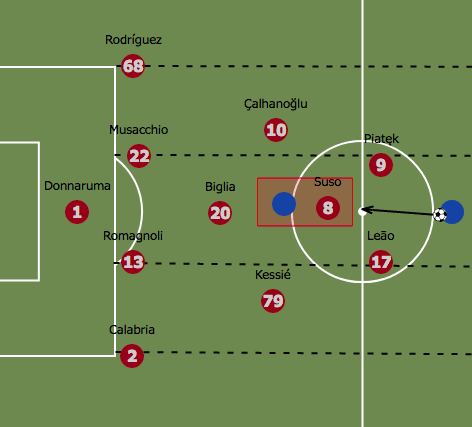
When the opponent had the ball on either wing the entire defensive shape would shift to that side – this movement, combined with the diamond’s natural narrowness, leaves AC Milan very susceptible to being stretched by opposing wingers who hug their touchline. As shown in the below example, Politano stretches AC Milan’s back line by staying tight to Hernández, even though Barella has the ball on the far left flank. Lukaku pins the central defenders, leaving them unable to aid their isolated full-backs. This leads to a goal.
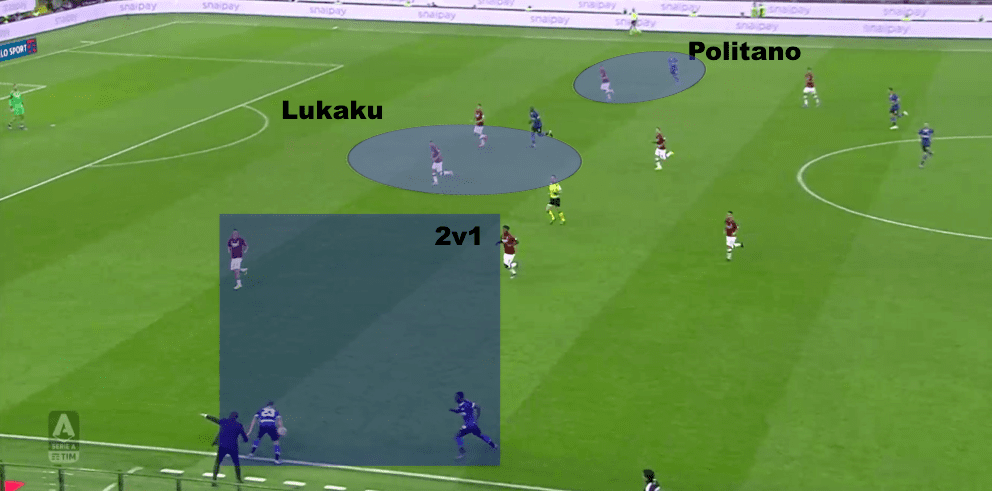
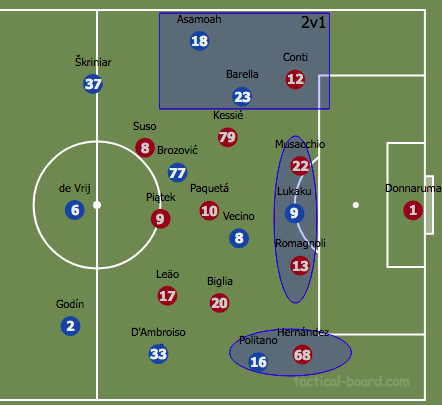
The below image is another example of AC Milan being stretched – this time both of Torino’s wingers stay wide, pinning Milan’s full-backs wide, leaving Torino with a dangerous 2 v 2 against Milan’s centre-backs.
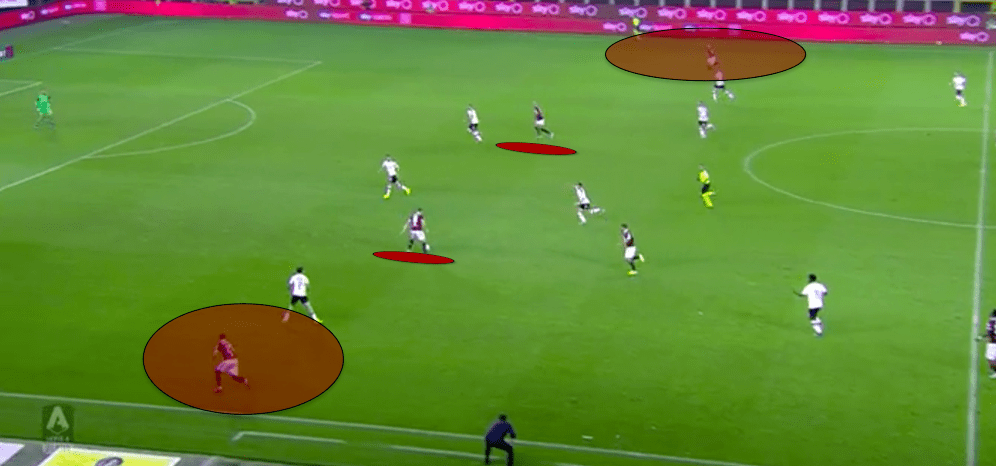
This season, AC Milan have conceded 1.28 goals per game in the league (9 goals conceded in 7 matches played). If averaged over a 38 game season, that amounts about 49 goals, which is a noticeable decline in defensive performance as AC Milan only conceded 36 goals last season, amounting to 0.95 goals conceded per game.
Offensive struggles and the misuse of Leão
AC Milan have only scored 6 goals after 7 games played. Their top scorer from last season Piatęk has only found the net twice, and the Polish striker is their current top scorer. This lack of goalscoring is emphasised when looking at other teams, Ciro Immobile has scored more goals for Lazio this season (7 goals) than the entire AC Milan squad. New signing Rafael Leão has arguably been AC Milan’s best player so far, but his role has not allowed him to show his goalscoring ability. Last season at LOSC Lille, Leão scored 8 goals while playing as a second striker just off of Jonathan Bamba and Nicolas Pépé, while this season he has been played in more of a left wing role, even though he appears as a striker on most teamsheets. Giampaolo used Leão in a wider role in order to try and stretch opposition defensive lines, instead of using him where he is most dangerous: running directly at the defence. Leão’s only goal under Giampaolo came in this position against Fiorentina, when Leão was allowed to play more centrally.
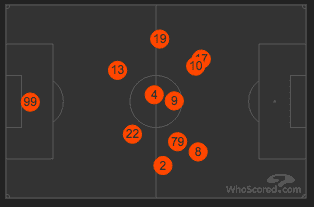
Summer Signings
AC Milan made six major summer signings:
Ante Rebić was loaned from Frankfurt (Striker/Winger)
Ismaël Bennacer was bought from Empoli (Central midfielder)
Rade Krunić was bought from Empoli (Central midfielder)
Léo Duarte was bought from Flamengo (Centre-back)
Rafael Leão was bough from Lille (Striker/Winger)
Theo Hernández was bought from Real Madrid (Left-back)
AC Milan transferred out the following major players:
André Silva was loaned to Frankfurt as a part of the Ante Rebić deal (Striker)
Diego Laxalt was sold to Torino (Left wing-back)
Patrick Cutrone was sold to Wolverhampton Wanderers (Striker)
Looking back at their summer window, most people would be impressed by AC Milan’s business. Rebić and Leão have been two of the most exciting forward players in their respective leagues before making the move to AC Milan. Bennacer and Krunić were two impressive midfielders in a poor Empoli team. Hernández is an exciting young left-back. The only questionable signing was Duarte – the Brazilian centre-back has only started one game under Giampaolo, but at 23 he is still relatively young, and he adds much-needed depth to the AC Milan squad.
Have AC Milan been “unlucky”?
The short answer is no. The main way to measure “luck” in football is to utilise the expected goals (xG) metric. AC Milan have scored 6 goals, while xG says they should have scored 7.63, so this discrepancy isn’t nearly enough for AC Milan to consider themselves unlucky in the goalscoring department. Their defensive numbers show even less of a discrepancy – AC Milan have conceded 9, while xG says they should’ve conceded 9.8, so they are scoring and conceding roughly what they should be. Their expected points value is 8.4 in comparison to their 9 leaving their expected position at 10th, exactly where they are as of Giampaolo’s sacking.
Were AC Milan too harsh in sacking Giampaolo? – Conclusion
After seven games, AC Milan sit 10th with nine points. At the same point in the 2016/17 season, during Sampdoria’s first seven games under Giampaolo, they had only seven points. Giampaolo being sacked so early may be a sign of ignorance by the board that a slow start may not signify the club’s form for the rest of the season. After all, Giampaolo did well enough at Sampdoria to merit getting the Milan job. I personally think that AC Milan didn’t give Giampaolo enough time to bed in his system, and he was sacked too early.
AC Milan actually haven’t been “bad” – it’s still very early in the season and if AC Milan had an extra three points they’d be sat in 6th, which shows how much early season results can skew the league table and lead to managers being sacked arguably much too early.
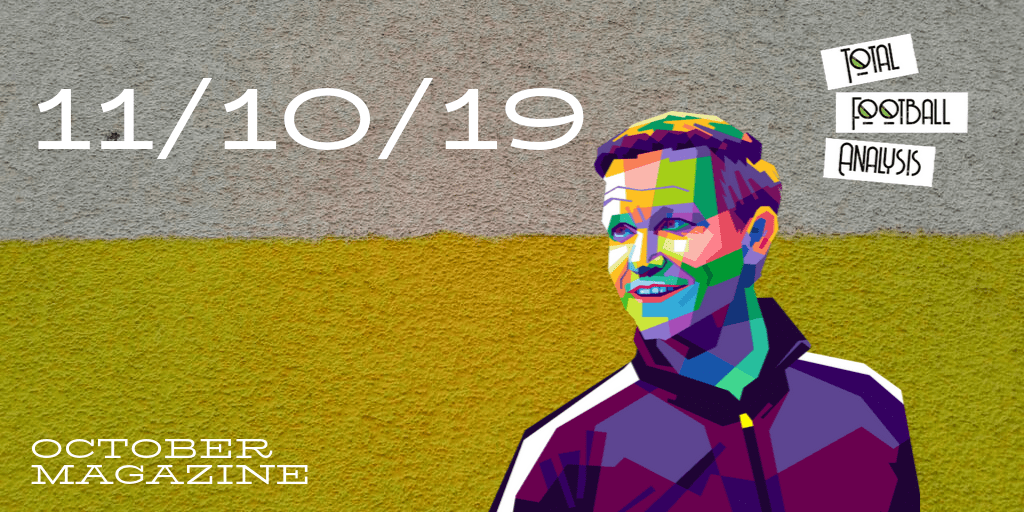
If you love tactical analysis, then you’ll love the digital magazines from totalfootballanalysis.com – a guaranteed 100+ pages of pure tactical analysis covering topics from the Premier League, Serie A, La Liga, Bundesliga and many, many more. Buy your copy of the October issue for just ₤4.99 here




Comments